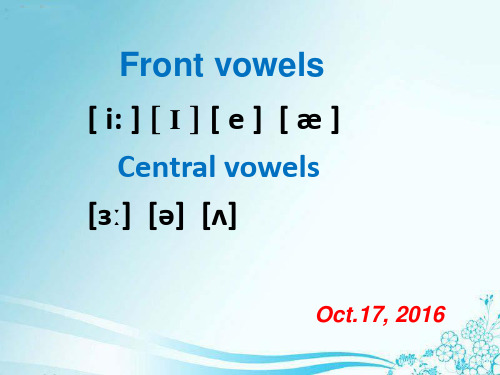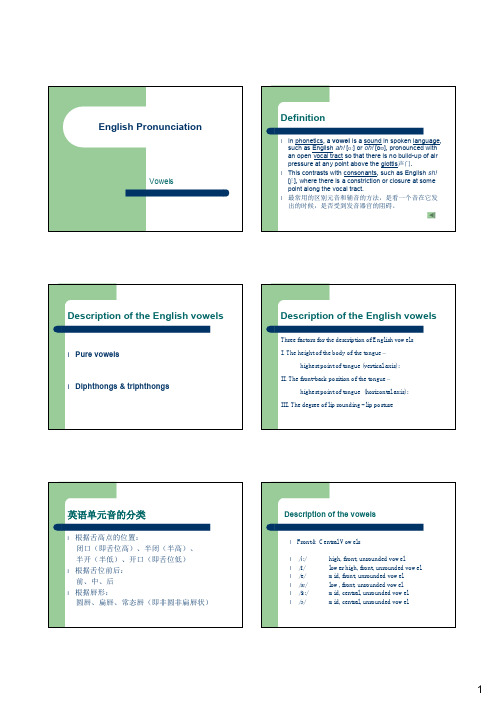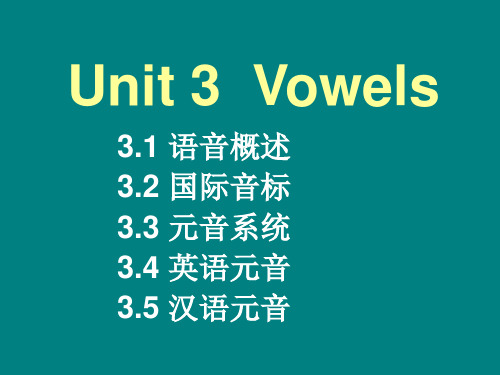vowels
Front vowels and central vowels

前元音小结
• • • • 发前元音时必须注意: 1) 舌尖要抵住下齿。 2) 舌前部向硬颚部分抬起。 3) 双唇不要收圆,发[ i: ] [ I ] [ e ] 时双唇平 展,发[ æ ]时口形要张大,扁唇。 • 4) 唇形舌位保持不变,否则就要发成双元 音。
• [ ɜː]
• •
• • •
vedio5.mp4 p38 音标特征:中元音 半高音 不圆唇 长元音 发音要领:舌身平放, 舌中部稍微抬起, 成自 然状态, 口半开半闭, 发长音[ ɜː]。 发音组合:or ir er ur ear 代表单词:work worker worm bird dirt affirm term burn surf pearl learn More practice on P40,41
/ ɜː /
1. dirty shirt 2. first term 3. work in a firm 4. nursing girl 5. third person
6. burning church 7. learn German 8. His words hurt 9. learn the verb 10. The bird heard
Listen and follow
• am add apple adverb active action actor • cap hat bad flag map carry happy
Listen to the recording and repeat the following phrases aloud.
Sound practice
• • • • /ʌ/ but bus cut dust hut study done money monkey fuss love glove nothing
vowels简介讲义

英语单元音的分类
l
Description of the vowels
根据舌高点的位置: 闭口(即舌位高)、半闭(半高)、 半开(半低)、开口(即舌位低) 根据舌位前后: 前、中、后 根据唇形: 圆唇、扁唇、常态唇(即非圆非扁唇状)
l l l l l l
Front & Central Vowels /:/ // /e/ /æ/ /:/ /ə/ high, front, unrounded vowel lower high, front, unrounded vowel mid, front, unrounded vowel low, front, unrounded vowel mid, central, unrounded vowel mid, central, unrounded vowel
2
l Diphthongs & triphthongs
II. The front-back position of the tongue – highest point of tongue (horizontal axis); III. The degree of lip rounding - lip posture
Description of the English vowels
Description of the English vowels
Three factors for the description of English vowels
l Pure vowels
I. The height of the body of the tongue – highest point of tongue (vertical axis);
Vowels 音标

• 上述八个元音称作主要定位元音(primary cardinal vowels),即用舌的前部但不圆唇的发音, 从高到低依次排列为[i]、[e]、[]和[a];用舌的后 部产生的元音从低到高依次排列为[]、[]、[o]和 [u],其中[]为非圆唇音,其余三个为圆唇音。这八 个元音可依次用1--8来表示。 • 在主要元音位置保持不变的基础上,如果改变舌的 形状,又能产生一个元音类的次要(secondary) 系列,即次要定位元音(secondary cardinal vowels)。其中,前元音由非圆唇变为圆唇,从高 到低分别生成[y],[],[]和[];在后元音中, []是对应于5号基本元音[]的圆唇音,[],[]和 []则分别对应于6,7,8号基本元音[],[o]和[u], 为非圆唇音。如图3–5所示:
• 从声音的共振作用看,共振腔或曲或直对共 振频率的影响不不大,成年男子的共振腔, 从声源处的声带开始,到声腔的终端双唇为 止,共约17厘米(成年女子略短一些)。 • 人们可以把这段距离比作一端封闭、一端开 放的管子,封闭的一端为声带,气流通过声 带时引发声带颤动,产生声带音,而后进入 这条管子,声带音在管子里发生共振,从管 子的开放一端释放出去,这样就形成了元音。 管子形状不同,起到的作用也不同,生成的 元音音质也就不同。图1是汉语普通话[]和 []的舌位图示:
Unit 3 Vowels
3.1 语音概述 3.2 国际音标 3.3 元音系统 3.4 英语元音 3.5 汉语元音
3.1 语音概述
• 话语成分总是构成于若干不断变化的最小音段 (segment)。根据发音动作的不同状态,人们把 这些最小的音段分为开放型和封闭型。开放型音段 指的是气流经过喉腔、咽腔、口腔和唇腔时,声腔 通道完全处于开放的状态,气流没有任何阻碍,能 够顺利通过。封闭型音段指的是声腔通道某一部分 封闭,气流受阻,不能畅通。在话语结构中,“开 放型音段和封闭型音段总是交替出现,形成音质各 不相同的、连续不断的最小音段”。 • 一般说来,开放型的最小音段称为元音,封闭型的 最小音段称为辅音。元音发音时响度较高,且音段 较长,总是处于音节的核心地位。与此相反,辅音 发音时音段一般较短,或虽能延长但响度较低,在 音节构成中总是处在从属的地位。
英语语音知识及语言学知识

英语语音知识【音素phoneme】The phoneme is the smallest unit of speech sound in a language that is capable of conveying a distinction in meaning,音素是构成音节的最小单位或最小的语音片段。
Front vowels(前元音):/i:/, /I/, /e/, /æ/Pure V owels/Monophthongs(单元音) Central vowels(中元音):/ə:/, /ə/V owels(元音) Back vowels(后元音):/ɔ/, /ɔ:/, /u/, /u:/, /ʌ/, /a:/(20) Falling diphthongs(合口双元音):/ei/ , /əu/, ai/, /au/, /ɔi/Diphthongs(双元音)Phoneme Rising diphthongs(集中双元音):/iə/, /ε/, /ə/, /uə/Stops(爆破音):/p/, /b/. /d/, /t/, /k/, /g/Fricatives(摩擦音):/f/, /v/, /θ/, /ð/, /s/, /z/, /ʃ/, /ʒ/, /h/Consonants(辅音) Affricates(塞擦音):/ts/, /dz/, /tr/, /dr/(28) Lateral(边音):/l/Nasals(鼻音):/m/, /n/, /ŋ/Approximants(半元音):/w/, /r/, /j/语言学知识Morpheme that occur “unattached” are called free morpheme.Inquiry and discovery learning is to involve learners in investing energy and attention in order to discoversomething about the language for themselves.Sapir-Whorf hypothesis is also known ad linguistic relativity.Pragmatic competence requires teacher to help learners to learn the relationship between grammatical formsand function.Phonetics is the study of the phonic medium of language; it is concerned with all the sounds that occur in theworld’s languages.Correct perception of sounds is vital for listening comprehension.Different stress and intonation indicate different meanings.The dialect which is caused by social status is socialect.The famous line “My love is a red, red rose”, stirs up vividly the imagination of a beautiful lady. This is theiconic meaning of “rose”.Linguistics is generally defined as the scientific study of language.The reasons for teaching writing to students of English as a foreign language include reinforcement, languagedevelopment, learning style and, most importantly, writing as a skill in its own right.The different phones which can represent a phoneme in different phonetic environment are called theallophones of that phoneme.Semantics is generally considered to be the study of meaning in language.。
后元音back vowels

sentences
6. It will do lot of harm to the heart. 7. Mark is only whistling in the dark. 8. The dog keeps barking in the dark. 9. After class Mark will go to the garden. 10. He is driving very fast the catch the last train.
sentences
6. You must pull out the decayed tooth. 7. Have you read the book “Roots”? 8. It’s very rude of you to treat that group like that. 9. He bought some fruit for the group. 10. He told the dentist that he had a loose tooth.
phrases
9. a lofty job 10. go to see a doctor 11. have a lot of hobbies 12. at the bottom of the society 13. eat a hot dog 14. at the bus stop 15. at the top of the mountain 16. do tip-top (干得很棒)
Phrases and sentences on dog
phrases
13. a bookish scholar 14. reach womanhood 15. sugary fruit 16. pull through (度过危机) 17. a bit crooked (走了形的) 18. walk through the woods
英语音标 English Vowels and Consonants

[r]舌头向上卷起,舌头不要接触任何部位,双唇稍突出,声带振动。
[h]自然呵气,自然张开,声带不振动(像喘气)。
Affricate consonants
破擦音
[tʃ]双唇略微张开突出,舌尖抵住上齿龈,用力吐气,舌尖离开上龈,声带不振动。
[u]嘴张开,略向前突出,发短促音。
Central vowels中元音
[ʌ]嘴巴张开,伸向两边,舌尖轻触下齿。
[ə:]嘴巴呈扁平,上下齿微张开,舌身平放。(长)
[ə]嘴巴呈扁平,上下齿微张开,舌身平放。(短)
Diphthongs双元音
Rising diphthongs
[ei]相当于发“A”
[ai]由开到合,“I”。
Nasal consonants
鼻辅音
[m]双唇紧闭,舌头平放,声带振动,气流从鼻子里送出来(鼻音).
[n]双唇微开,舌尖抵上齿龈,声带振动,气流从鼻子里送出来(鼻音).
[ŋ]双唇张开,舌尖抵下齿龈,舌根向后抵住,声带振动,气流从鼻子里送出来(鼻音).
Lateral consonant
边辅音
[l]舌尖抵住上齿龈,舌尖轻微用力弯曲,声带振动
[b]双唇紧闭,然后快速张开,爆破音,声带振动。
[t]用舌尖发音,抵住上齿龈形成阻碍(短促有力),声带不振动。
[d]用舌尖发音,抵住上齿龈形成阻碍(短促有力),声带振动。
[k]声带不振动,气从喉咙里用力冲出,舌后部抵住软腭。
[g]声带振动,气从喉咙里用力冲出,舌后部抵住软腭。
Fricative consonants
[ɔi]前重后轻,由圆到扁,稍快。
[əu]口型有半开到小开,像发“O”,发“ə”时舌尖抵下齿。
英语语音vowels

Let’s practice!
1. Don’t let the cat out of the bag. 2.That’s why she is mad. 3. Thank you for the stamps. 4. A black cat is catching a fat rat. 5. He has a very happy family.
[e]
发音时,口形扁平,上 下齿之间约能伸进一根 手指。舌尖抵住下齿, 舌前部稍稍上台的趋势, 但没有[i]那么明显。
前元音 [ e ]
Let’s practice!
Bed,
pen, let, men, yet, then,
desk Rest, next, letter, lesson, tell, dead, head Bread, friend, many, step, forget, eleven
Let’s practice!
None of your business. You are kidding. Does it fit? Bill is very rich. Where are the kids? She is a pretty lady. Zip your lips. Jim is sick. A fall into the pit, a gain in your wit.
发音要领:
收唇,前撅,收小,略外翻。‘嘘’ 声口型。
英语发音的三种主要舌位
上舌位 中舌位
下舌位
英语的元音是靠舌根的运动来发音的,
属于舌根音。同时,舌部具有三种发 音位置:上舌位,中舌位和下舌位。 掌握好这三种舌位及舌根的运动才能 发好,发准英语的元音。
vowels

summary
[u:] tense long, close back rounded [u] lax short, close back rounded [D:] tense long, half-open back rounded [D] lax short, open back rounded [a:] lax long, open back unrounded
[i:] [i] [e]
[æ ]
[i:] beat meet
穿针引线、长衣
[i:] tense long close, front, unrounded
[i] hit bit pit
经典收小腹、 减肥急促短衣
[i] lax Short close, front, unrounded
[i:] and [i ]
said
pet
sad
pat
pen
pan
sentences
★ Well, let’s tell Ted to get ready for the test. ★ I’m glad I am not married to that bad-tempered
man.
poem
★Good,
better, best, ↗ Never let it rest; ↘ Till good is better, ↗ And better best. ↘
◆ Approximants : [w], [j], and [r] [l]
Place of articulation
★1. bi-labial: [p], [b], [m], [w] ★ 2. labio-dental: [f], [v] ★ 3. dental : [ø] [ð] ★ 4. alveolar: [t], [d], [s] [z], [n],[l] [r] ★5.palato-alveolar :[∫], [ζ], [t∫], [d3] ★ 6. palatal: [j] ★ 7. velar: [k], [g], [η]. ★ 8. glottal: [h]
- 1、下载文档前请自行甄别文档内容的完整性,平台不提供额外的编辑、内容补充、找答案等附加服务。
- 2、"仅部分预览"的文档,不可在线预览部分如存在完整性等问题,可反馈申请退款(可完整预览的文档不适用该条件!)。
- 3、如文档侵犯您的权益,请联系客服反馈,我们会尽快为您处理(人工客服工作时间:9:00-18:30)。
Exercises P37-39 The Closing Diphthongs
Exercise 1:
No.13 No.14 No.15
No.16 No.17
[eI] tape bay name spade vague
[əu] toe boat nose spoke vote
[aI] tie buy night spy vice
An initial classification will divide the speech sounds in English into two broad categories: vowels and consonants. Here are two definitions of vowels:
monophthongs:单元音 ['mɔnəfθɔŋ]
① ② ③ ④
As in the production of vowels the air stream meets with no obstruction. Vowels are differentiated by the following factors: the position of the tongue the openness of the mouth the shape of the lips the length of the vowels
u & u:
P22
higher
ɔ: lower
ɔ &ɔ:
P21 P20
ɔ lowest æ & ɑ: ɑ:
Exercises P22-24 The Back Vowels
Exercise 1: Exercise 2: Exercise 3: Exercise 4: Exercise 5:
diphthongs ['difθɔŋ ] : 双元音
3.
4.
[aIə] tyre trial quiet buyer iron tired
[auə] tower towel coward bower flower shower
5.
[ɔIə] royal employer moiety
open vowels: [æ] [ʌ] [ɔ] [ɑ:]
the shape of the lips
unrounded vowels: without rounding the lips; in English, all the front vowels and the central vowels are unrounded vowels
[au] town bow now spout vow
[ɔI] toy boy noise spoil voyage
Exercises P37-39 The Closing Diphthongs
Exercise 2:
Exercises P37-39 The Closing Diphthongs
Exercise 3:
the front vowels
monophthongs: [„mɔnəfθɔŋ]
the central vowels
the back vowels the closing diphthongs the centrins: [„difθɔŋ ] triphthongs: ['trifθɔŋ]
P26
ə:
ə ʌ
higher ɑ:& ʌ
P26
lower ə:& ə
lowest
P28
Exercises P28-29 The Central Vowels
Exercise 1: Exercise 2: Exercise 3:
The Back Vowels
front central
u:
u
back highest 1
P40 P41
P42
Common feature: Figure 27 P39 The tongue is centralizing to the central vowel [ə ] from another position of the mouth.
Exercises P42-43 The Centring Diphthongs
rounded vowels: all the back vowels with the exception of [ɑ:] , are rounded.
the length of the vowels
long vowels: tense vowels; the larynx is in a state of tension short vowels: lax vowels; the larynx is quite relaxed
the position of the tongue:
Front vowels: the front part of the tongue maintains the highest position; [i:] [ I ] [e] [æ] Central vowels: the central part of the tongue maintains the highest position; [ə:] [ə] [ʌ]
“Vowels are modifications of the voice-sound that involve no closure, friction, or contact of the tongue or lips.” “A vowel is defined as a voiced sound in forming which the air issues in a continuous stream through the pharynx and mouth, there being no audible friction.”
. . . E.g. our ['auə] not ['auwə] tower [„tauə] not [„tauwə]
.
.
Exercises P38 The Triphthongs
Exercise 4:
1. 2.
[eIə] greyer player betrayal [əuə] grower follower thrower
The two definitions point to one important feature of vowels, i.e. in producing a vowel the air stream coming from the lungs meets with no obstruction whatsoever. This marks the essential difference between vowels and consonants. In the production of the latter category—the consonants, it is obstructed in one way or another.
1. 合口双元音(The Closing Diphthongs): [eI] [əu] [aI] [au] [ɔI]
P33
P34
P34
P35 P36
Common features: 1. The openness of the mouth is from open, semi-open to semi-close. 2. The position of the tongue is becoming higher.
Exercise 1: Exercise 2: Exercise 3:
Exercises P42-43 The Centring Diphthongs
Exercise 3:
1. 2. 3. 4. 5.
A. peace A. bear A. pear A. pier A. mare
B. pierce B. beer B. poor B. pear B. moor
Back vowels: the back part of the tongue maintains the highest position; [u:] [u] [ɔ:] [ɔ] [ɑ:]
the openness of the mouth
close vowels: [i:] [ I ] [u:] [u] semi-close vowels: [e] [ə:] semi-open vowels: [ə] [ɔ:]
Exercises P39
Exercise 5: Circle the words you hear.
1. 2. 3. 4. 5.
A. shed A. walk A. cart A. fined A. corn
B. shade B. woke B. kite B. found B. coin
2. 集中双元音(The Centring Diphthongs): [Iə] [εə] [uə ]
In English there are also a number of diphthongs, which are produced by moving from one vowel position to another through intervening positions. 1. 合口双元音(The Closing Diphthongs): [eI] [əu] [aI] [au] [ɔI] 2. 集中双元音(The Centring Diphthongs): [Iə] [εə] [uə ]
